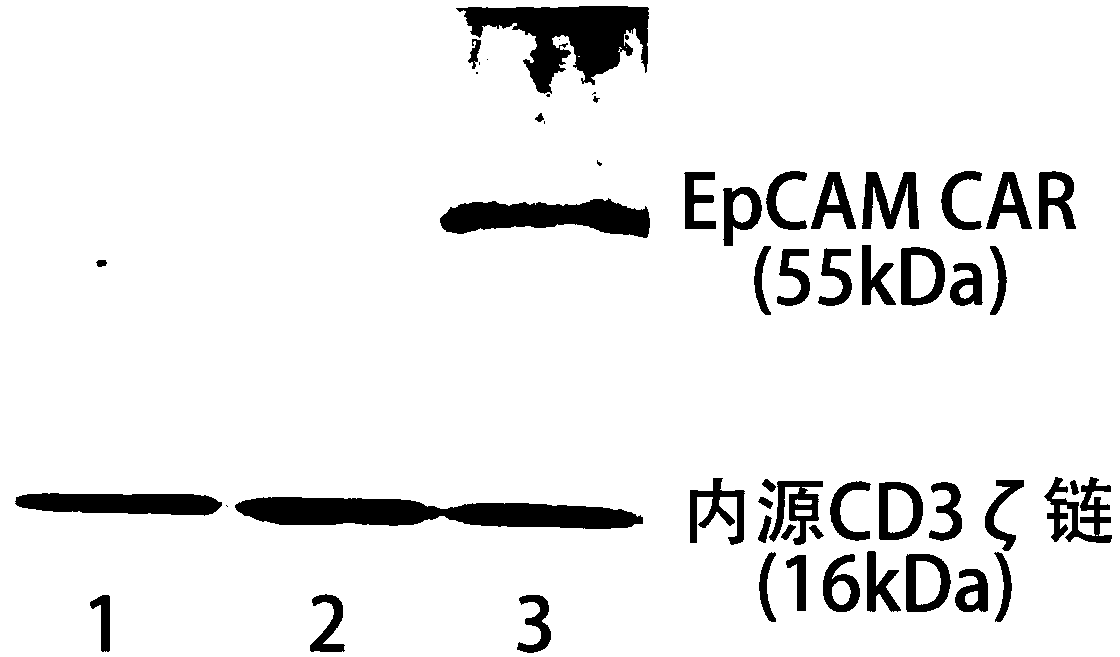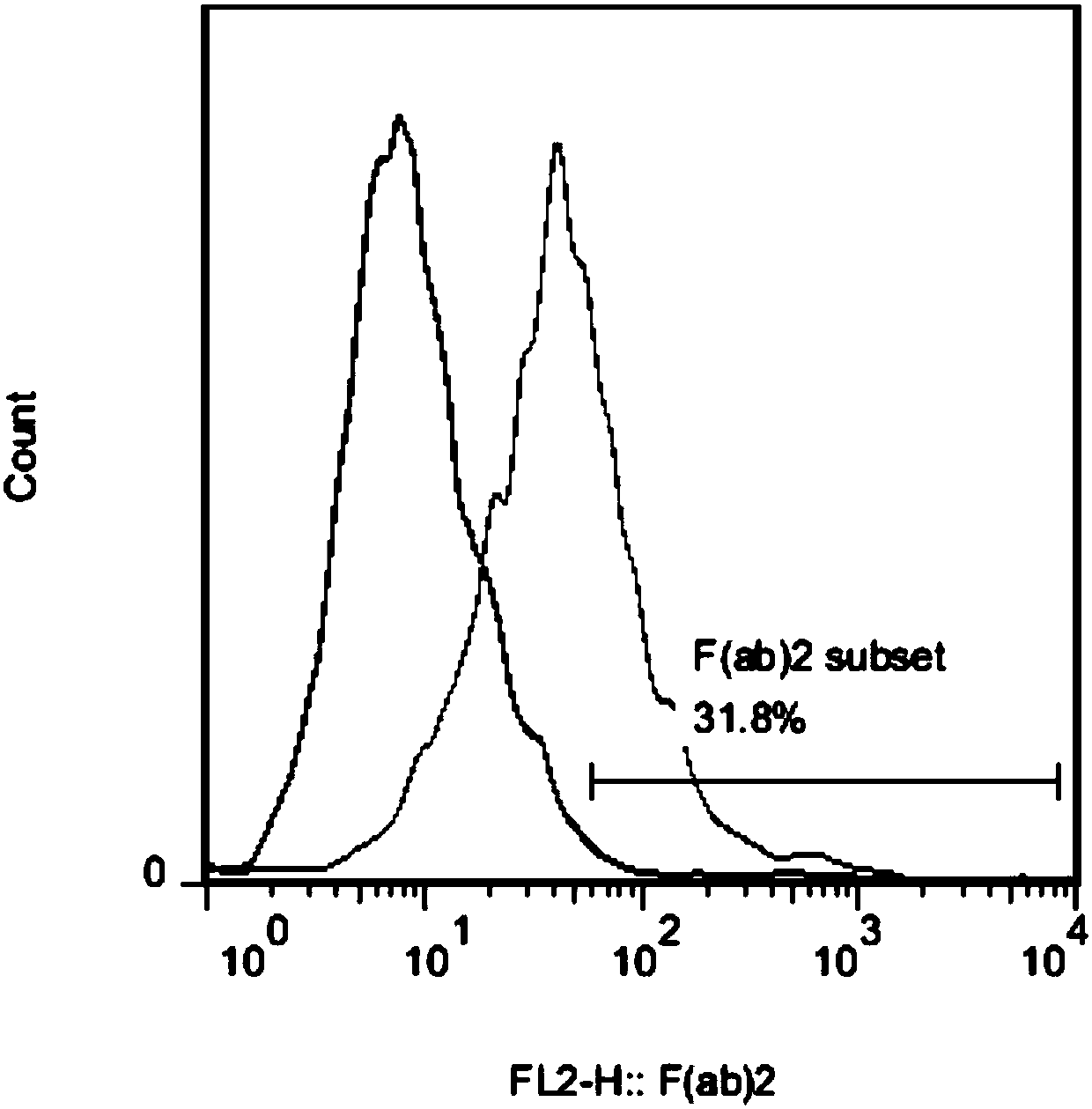Human EpCAM targeted genetically engineered lymphocyte, preparation method and use thereof
A lymphocyte and gene technology, applied in the field of genetic engineering, can solve the problem of no effective chimeric antigen receptor report and so on
- Summary
- Abstract
- Description
- Claims
- Application Information
AI Technical Summary
Problems solved by technology
Method used
Image
Examples
Embodiment 1
[0067] Example 1 Obtaining the full-length CAR gene and completing the construction of the recombinant plasmid vector
[0068] 1. Synthesize primers to obtain (ScFv-V)-(CD8α)-(CD28)-(4-1BB)-(CD3-z) fusion fragment by overlapping PCR method.
[0069] 2. Obtain the full-length CAR gene by overlapping PCR.
[0070] The specific plan is as follows:
[0071] a) Use primers F1 and R1 to amplify the coding gene of ScFv-E segment, and use F2 and R2 to amplify the coding gene of (CD8α)-(CD28)-(4-1BB)-(CD3-z). Among them, the gene codes of ScFv-E, (CD8α)-(CD28)-(4-1BB)-(CD3-z) were all obtained by chemical synthesis (synthesized by Guangzhou Funeng Gene Co., Ltd.).
[0072] b) Using ScFv-E and (CD8α)-(CD28)-(4-1BB)-(CD3-z) as templates and F1 and R2 as primers, the full-length CAR gene was obtained by PCR.
[0073] Primers (5' to 3') used to obtain the CAR gene:
[0074] F1 (SEQ ID NO: 12):
[0075] 5'-GCtctagaATGTACAGGATGCAACTCCTGTCTTGC-3';
[0076] R1 (SEQ ID NO: 13):
[0077] ...
Embodiment 2
[0084] Example 2 Transfection of Lymphocytes, Expression Detection
[0085] 1. Virus transfection of lymphocytes and detection of target gene expression.
[0086] Put the chimeric antigen receptor gene prepared in Example 1 into the lentiviral vector CD510B-1-pCDH, and co-transfect 293T cells (purchased from ATCC cell bank) with the other two auxiliary vectors psPAX2 and pMD2.G , packaged to obtain virus particles, and obtain high-titer lentiviral vectors after centrifugation and concentration. After T lymphocytes were isolated from human peripheral blood by density gradient centrifugation, the lymphocytes were stimulated with CD3 antibody (lug / ml) and IL-2 (300IU / ml). Two days later, the lymphocytes were collected for virus transfection, and the lymphocytes were cultured for 48 hours. The transfected lymphocytes were collected, and the total protein of the cells was extracted for western blotting. The results showed that CAR was highly expressed in transfected T lymphocytes...
Embodiment 3
[0089] Example 3 Killing effect on tumor cells expressing EpCAM
[0090] To investigate the killing effect of CAR genetically engineered T cells that can specifically recognize EpCAM on tumor cells. use 51 Cr release assay to detect the targeted killing effect of genetically engineered T cells dependent on the expression level of EpCAM.
[0091] Implementation process: Target cells Hela, MDA-MB 231 and SW480 with different EpCAM expression levels were labeled with sodium chromate and seeded into 96-well plates. At the same time, T cells infected with EpCAM CAR virus (EpCAM CAR-T) cells were used as effector cells, and the EpCAM CAR-T cells were added to the 96-well plate by counting at the effect-to-target ratio of 10:1, 5:1 and 2.5:1. , and incubated with target cells. At the same time, T cells not infected with EpCAM CAR virus (No CAR-T) were used as a control, counted at the same effect-to-target ratio, and added to a 96-well plate to incubate with target cells. Three s...
PUM
 Login to View More
Login to View More Abstract
Description
Claims
Application Information
 Login to View More
Login to View More - R&D
- Intellectual Property
- Life Sciences
- Materials
- Tech Scout
- Unparalleled Data Quality
- Higher Quality Content
- 60% Fewer Hallucinations
Browse by: Latest US Patents, China's latest patents, Technical Efficacy Thesaurus, Application Domain, Technology Topic, Popular Technical Reports.
© 2025 PatSnap. All rights reserved.Legal|Privacy policy|Modern Slavery Act Transparency Statement|Sitemap|About US| Contact US: help@patsnap.com



